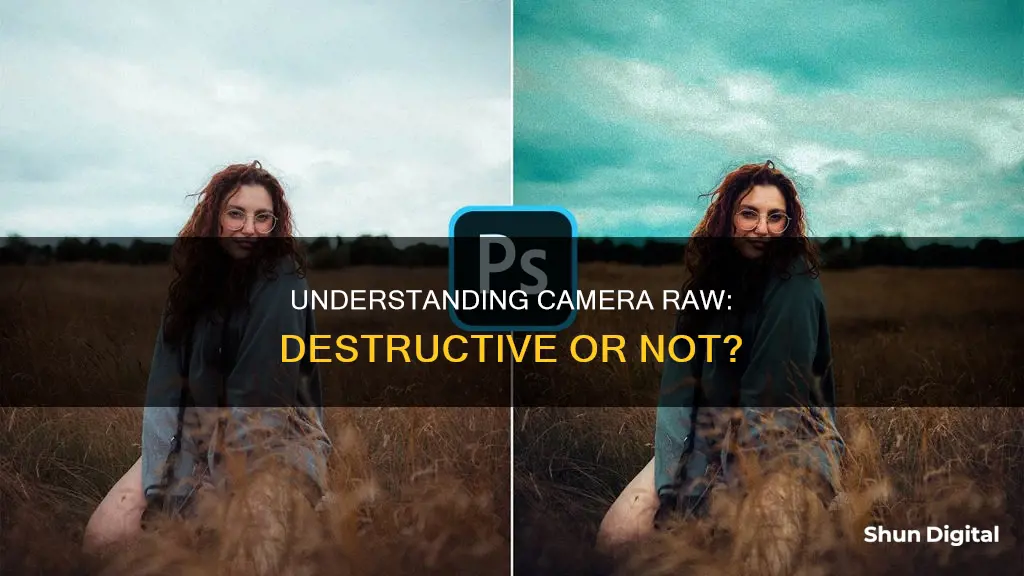
Adobe Camera Raw is a powerful and intuitive plugin in Photoshop that allows users to make quick and professional editing adjustments to their photos. Importantly, it makes those edits in a non-destructive way, meaning it's easy to reverse the changes and the original files are not altered in any way. Camera Raw is particularly useful for editing RAW image files, which are produced by digital cameras and contain uncompressed picture data that must be processed by software before they can be viewed.
| Characteristics | Values |
|---|---|
| Nature of editing | Non-destructive |
| Original image | Unchanged |
| Edits | Can be reset |
| File format | Raw |
| File size | Larger than JPEG |
| Image detail | More detail than JPEG |
| Image processing | Requires software |
| Image preview | Live |
| Image adjustments | Exposure, colour, temperature, contrast, sharpness, vignette, noise reduction |
| Image selection | Multiple images can be edited simultaneously |
| Image export | Batch export possible |
| Image organisation | Flag and label images |
What You'll Learn

Camera Raw is non-destructive
Adobe Camera Raw is a non-destructive image processor. This means that when you edit a photo, the original image remains untouched. Instead, your edits are saved as a set of instructions that are applied to the photo, and you see a live preview of the edited image as you work.
When you open a raw file in Photoshop, Camera Raw automatically opens. Here, you can make adjustments to the photo's exposure, colour, contrast, and more. You can also crop, sharpen, and rotate your images. These adjustments are saved as metadata in an accompanying sidecar file, in a database, or in the file itself (in the case of DNG format).
The fact that Camera Raw is non-destructive means that you can easily reverse changes and revert to the original image. This makes it a great tool for beginners, as you can experiment with edits without worrying about permanently altering your image.
Camera Raw is also useful for batch editing. You can open multiple images at once and sync your edits across all of them, saving time and effort.
Overall, Camera Raw is a powerful and intuitive tool for editing photos non-destructively. It is included with Photoshop in the Creative Cloud suite and can be accessed through Adobe Bridge.
Polaroid Camera Battery: Where is it Located?
You may want to see also

Original photo is unchanged
When you edit a photo using Adobe Camera Raw, the original photo is left completely untouched. Camera Raw is a non-destructive image editor, meaning that it does not alter the original image data. Instead, it saves your edits as a set of instructions that are applied to the photo. This is known as parametric editing.
When you open a photo in Camera Raw, you are creating a new derivative image based on the original raw capture. Any changes you make are saved as metadata in an accompanying 'sidecar' file, in a database, or in the file itself (in the case of DNG format). This means that you can always revert to the original photo, even after you've made changes and closed the file.
Camera Raw is different from Photoshop in this regard, which is a pixel-based editor. When you work on a photo in Photoshop, it makes changes to its pixels, which is called destructive editing. While there are ways to work non-destructively in Photoshop, such as using layers and adjustment layers, it is not non-destructive by nature like Camera Raw.
The non-destructive nature of Camera Raw gives you the freedom to experiment with your edits without worrying about permanently altering your original photo. You can always go back and start over with an unaltered original capture.
In addition, the fact that Camera Raw does not alter the original image data means that you can easily sync your edits across multiple images. This is a significant advantage when you have a batch of photos taken under similar conditions, as you can apply the same settings to all of them instantly.
Labeling Camera Batteries: A Quick Guide to Best Practices
You may want to see also

Edits are saved as instructions
Adobe Camera Raw is a non-destructive editing tool. This means that when you make changes to your image, the edits are saved as a set of instructions, or metadata, that are applied to the photo. The original image remains untouched, and you can go back and make changes as often as you want without ever harming a single pixel.
When you open a raw file in Photoshop, the Camera Raw interface may seem a little scary, with lots of sliders and buttons. However, it is actually pretty straightforward to use. Camera Raw is a parametric editor, which means that it uses nothing more than a series of instructions to tell the software how to display the image on the screen. As you process and develop an image in Camera Raw, it records and saves all of your settings as a list of instructions. What you see on the screen is not the edited image, but a live preview of how the image looks based on the current instructions. If you move a slider or change an option, Camera Raw simply updates the instructions and the live preview, so you can see how your changes are affecting the image without actually applying the changes to the image itself.
The important thing to understand is that with Camera Raw, the original photo and the instructions on how to process the photo are two completely separate things. No changes are ever made to the original image data. All you are doing is giving Camera Raw instructions on how to display the image. You can give it instructions on exposure, colour saturation, cropping, and more, and you can change these instructions as many times as you want with absolutely no loss of image quality.
The changes you make are stored in either the Camera Raw database, as metadata embedded in the image file, or in a sidecar XMP file (a metadata file that accompanies a camera raw file).
Kodak Camera Battery Drain: Why It Happens and How to Fix It
You may want to see also

Original capture is never altered
When you edit a photograph using Adobe Camera Raw, you are not changing the original image file. Instead, you are creating a new image based on the original capture. This is because raw image files are not truly image files, but rather data files containing the information gathered by the image sensor at the time the photograph was taken.
Any changes you make to a raw image file are saved in an XMP "sidecar" file, which is separate from the original capture. This means that the original image data remains unaltered, and you can always go back to it and start editing again from scratch. This is known as non-destructive editing.
The same is true when using Adobe Lightroom to edit raw image files. Lightroom also uses the same raw image-processing technology as Adobe Camera Raw.
In contrast, when you open an image in Photoshop, it is possible to permanently alter the image in a "destructive" way. For example, you could open an image, paint pixels over it, save and close the file, and never be able to get back to the unaltered original.
However, there are ways to work in Photoshop that are non-destructive, such as duplicating an image, using layers, adjustment layers, and Smart Objects.
Charging the A7 Camera: A Step-by-Step Guide
You may want to see also

Changes are easy to reverse
Adobe Camera Raw is a non-destructive photo editing tool, meaning that it is easy to reverse changes and original files remain unchanged. When you process a raw capture, any applicable settings are saved in an XMP "sidecar" file rather than altering the original capture. This means that you can go back and make changes as often as you want, or you can completely reset your changes without ever harming a single pixel.
If you want to revert to the original image, you can do so by selecting the drop-down menu to the right of the word "Basic" in the basic editing window and choosing "Camera Raw Defaults". You can also undo changes by opening the raw file in ACR and manually undoing them, for example by selecting the crop tool, then right-clicking and clearing the crop. Another way to undo changes is to simply delete the XMP file.
If you are using Adobe Bridge, you can revert to the original image by right-clicking on the image thumbnail in the Filmstrip View and selecting "Develop Settings" > "Clear Settings".
Action Camera Batteries: How Long Do They Last?
You may want to see also
Frequently asked questions
No, Camera Raw is a non-destructive image processor. It does not alter the original raw capture or raw file produced by your digital camera. Instead, it creates a new derivative image based on the original capture.
Camera Raw uses parametric editing, which means it uses a series of instructions (metadata) to tell the software how to display the image on the screen. The original photo and the instructions on how to process it are separate, so you can always revert to the original image.
Camera Raw offers quick and powerful edits to your photographs. It is straightforward to use and allows for non-destructive editing, giving you complete creative freedom. It also supports batch editing, which is more complicated to do in Photoshop.







